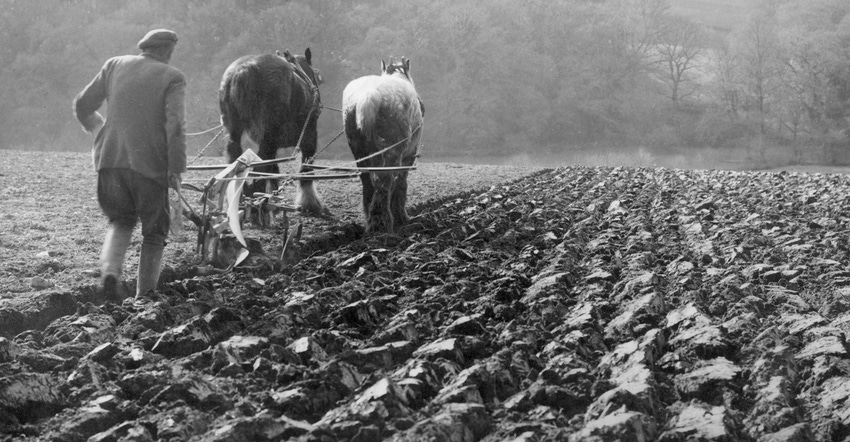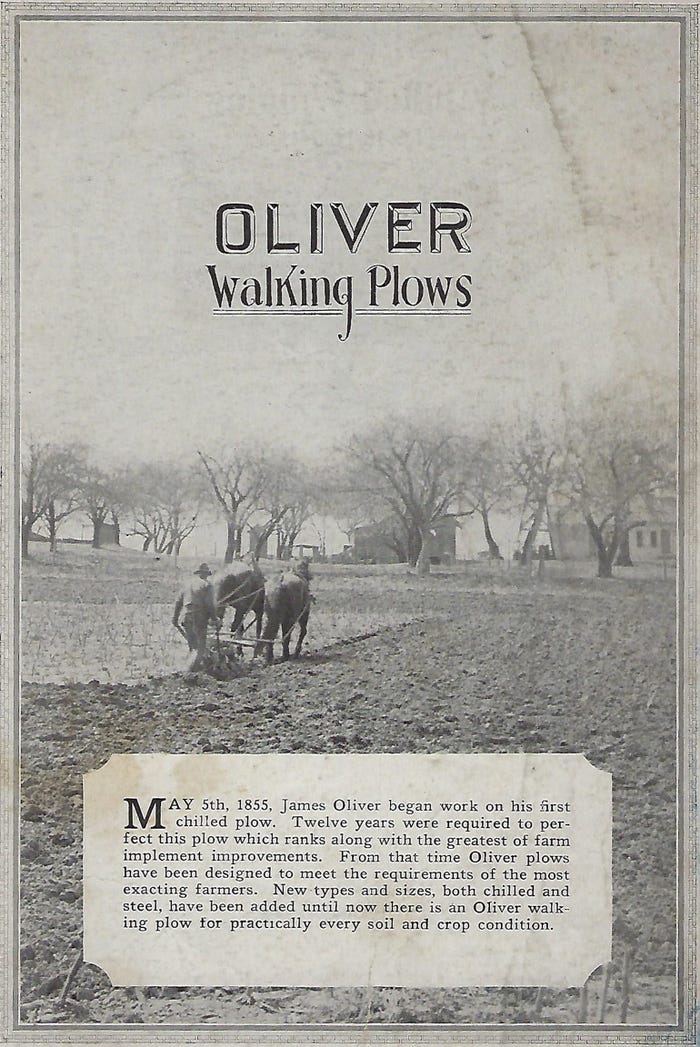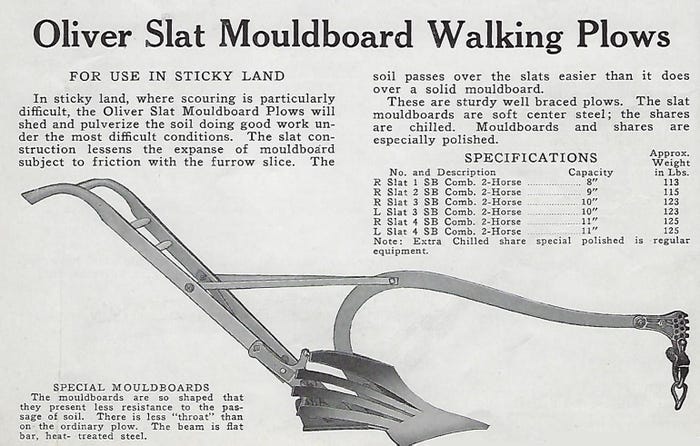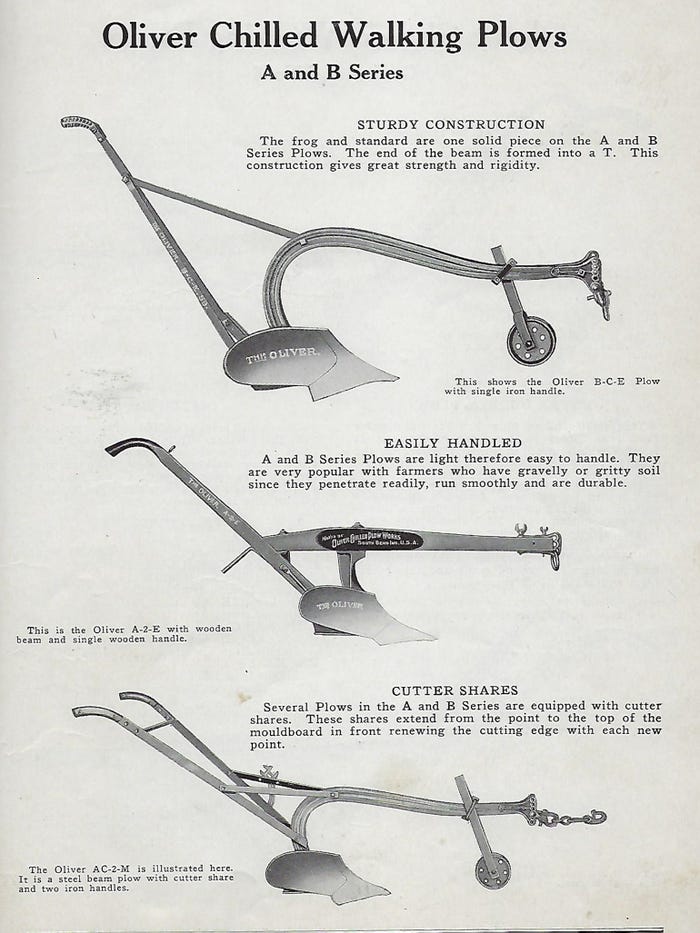November 29, 2018

If you’re going to make a claim like “Plowmakers for the world,” you better back it up. In the Oliver Walking Plows Sales and Parts Catalog 1-A, now yellowed and dog-eared, the company staked its claim. There are no fewer than 125 models of walking plows!
We’re talking one-bottom plows with handles and a hitch out front to hook up horses. If you wonder how your granddad or great-granddad stayed in shape, it’s because where those horses and that one-bottom plow went, he went — on foot.
Today your choices are what type of autosteer to add so you don’t have to steer the tractor, let alone walk. In the future, it may be which system to use to control an autonomous tractor. But a century-plus ago, the choice was which plow did you want to invest your hard-earned money in? Or which handles did you want to hold all day, or which plow bottom did you want to see in front of you furrow after furrow?
 ‘MODERN’ TIMES: This scene was typical of the day when the Oliver Walking Plows Catalog 1-A was printed.
‘MODERN’ TIMES: This scene was typical of the day when the Oliver Walking Plows Catalog 1-A was printed.

The cheapest autosteer on the market today costs $3,500, and most are more expensive. The most you could spend on a walking plow based on this catalog was around $20, and most cost about $10.
Choose your plow
Here’s a sampling of plows you could choose from offered by Oliver, South Bend, Ind.
• Oliver chilled walking plow, A and B series. The A-2 chilled one-horse plow was for small farms and gardens.
• Goober M SB chilled one-horse double iron handles. This one-horse plow was popular in Southern states.
• Oliver No. 46 steel sugar plow. For Cuba or sugarcane country, this plow’s moldboard was long and well-curved to turn the furrow slice over completely and pulverize it.
• Oliver No. 12 SB chilled two-horse plow. Farmers with gritty soils inclined to be sticky liked these plows. Soil scientists today would likely describe them as sandy clay loam soils. Moldboards were shaped to produce better results with these soils.
• Oliver 222 SB chilled right-handed three-horse plow. This was a general-purpose plow for all soil types. An extra chilled, small share ahead of the plow bottom was standard. Options included gauge wheels, jointers, and hanging and rolling ag coulters.
• Oliver slat 3 SB combination two-horse plow. You may have first seen slatted plow bottoms on Allis-Chalmers plows, but Oliver first made several models of slatted walking plows for sticky soils where scouring was difficult. The slat design offered “less resistance to the passage of soil.”
 UNIQUE PLOW: Slatted moldboards obviously date way back. Oliver engineers discovered sticky soils would scour best with slatted plow bottoms.
UNIQUE PLOW: Slatted moldboards obviously date way back. Oliver engineers discovered sticky soils would scour best with slatted plow bottoms.

• Oliver O-97-D SB combination two-horse plow. Also known as a slip-nose plow, the point of the share was separated from the wing and could be replaced easily and cheaply. The plow was popular in rocky areas.
• Oliver 42 steel plow with combination bottoms. The moldboard was made of soft center steel, and the shares were chilled steel. The design and construction of the moldboard “afforded unusual scouring qualities.”
• Oliver 403 WB steel two-horse plow. This walking plow weighed only 80 pounds, yet had a steel beam and could plow under small brush.
• Oliver Crescent Series 8. This plow featured a wood beam and rolling coulter out front. The Crescent 3-B used an iron beam and single iron handle.
 FEW OF MANY: Here are just a few of more than 125 walking plows offered in the Oliver catalog.
FEW OF MANY: Here are just a few of more than 125 walking plows offered in the Oliver catalog.

Comments? Email [email protected].
You May Also Like




